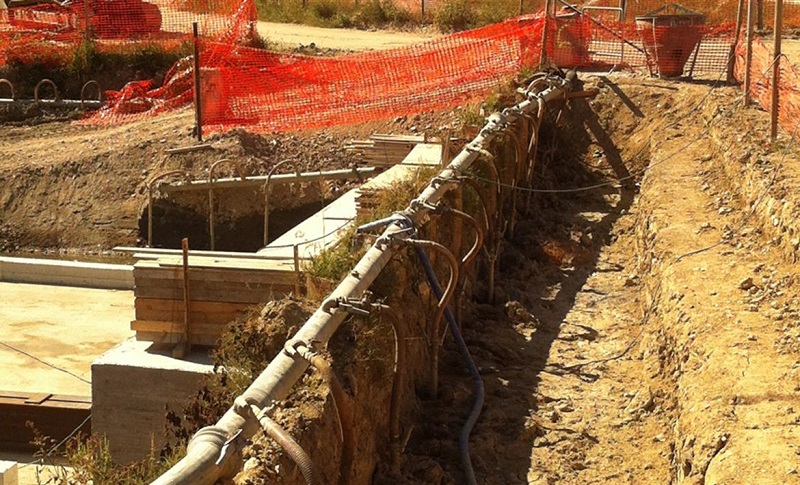Wellpoint
A wellpoint, also known as a drive point, is a small diameter well used for dewatering. It consists of a shallow shaft, a dewatering pump to draw water, a riser pipe which connects the wellpoint to the surface, and a small ‘well’ that fills up.
The riser pipes tend to be around 38-50 mm in diameter, with slots or openings at the bottom which enable water to be drawn up using the pump. The size of the openings is determined by the relative grain size of the water-bearing formation material. The openings should be large enough to allow water to enter the tube, but small enough to keep the water-bearing formation in place.
The riser pipe is often connected to a common header main pipe through a flexbow. This flexbow incorporates an adjustable valve which serves two purposes: firstly, it controls the flow of air and water entering the system; and secondly, allows a clear view of what is being pumped. The header main pipe is then connected to a wellpoint dewatering pump.
Wellpoints are fairly versatile and can be used for a wide range of applications. They are suitable for shallow foundations and trench works, particularly for long pipeline trenches where wellpoints may be installed in parallel by special trenching machines.
They can also be used for the irrigation of small to medium-sized residential gardens. If the water yield from one well is not sufficient for running an irrigation system, a second can be installed and connected to the first, enabling them to operate as one system.
They can also be used around the perimeter of excavations as an alternative to boreholes, as a means of lowering and controlling groundwater levels. They can be more cost- and time-efficient than a borehole due to the shallower depths required. In appropriate ground conditions, a wellpoint system can be installed very quickly. Traditional drilling techniques, such as jetting or auguring are typically used for installation.
Wellpoints tend not to yield large quantities of water – around 5 gallons per minute is typical. There is generally a limit of about 5-6 m in height over which water can be drawn as the vacuum is limited in practice to 0 bar. However, a second stage of wellpoints can be installed at a lower level if greater depths are required. They are capable of dealing with very low flows in silty sands as well as much larger flows in coarse sands and gravel.
Some of the benefits of using wellpoints include:
- Quick installation in most ground conditions.
- Easy to maintain.
- Capable of being used for both large and small-scale projects.
- Self-jetting wellpoints can be used in situations where there is limited space.
[edit] Find out more
[edit] Related articles on Designing Buildings Wiki
Featured articles and news
Wellbeing in Buildings TG 10/2025
BSRIA topic guide updates.
With brief background and WELL v2™.
From studies, to books to a new project, with founder Emma Walshaw.
Types of drawings for building design
Still one of the most popular articles the A-Z of drawings.
Who, or What Does the Building Safety Act Apply To?
From compliance to competence in brief.
The remarkable story of a Highland architect.
Commissioning Responsibilities Framework BG 88/2025
BSRIA guidance on establishing clear roles and responsibilities for commissioning tasks.
An architectural movement to love or hate.
Don’t take British stone for granted
It won’t survive on supplying the heritage sector alone.
The Constructing Excellence Value Toolkit
Driving value-based decision making in construction.
Meet CIOB event in Northern Ireland
Inspiring the next generation of construction talent.
Reasons for using MVHR systems
6 reasons for a whole-house approach to ventilation.
Supplementary Planning Documents, a reminder
As used by the City of London to introduce a Retrofit first policy.
The what, how, why and when of deposit return schemes
Circular economy steps for plastic bottles and cans in England and Northern Ireland draws.
Join forces and share Building Safety knowledge in 2025
Why and how to contribute to the Building Safety Wiki.
Reporting on Payment Practices and Performance Regs
Approved amendment coming into effect 1 March 2025.
























Comments